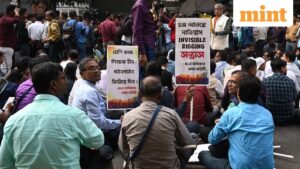On September 8, 2025, the Government of India issued a memorandum to fast-track “projects involving mining of critical, strategic, and atomic minerals.” What this means is that atomic minerals like uranium and thorium, categorized as strategic minerals, can now be mined without consulting the community that lives in the surroundings close to the deposit. The ironic part, an environmental clearance process is now being removed for the sake of meeting the climate change goal: “Net zero commitment of India by 2070.”
This key transformation in India’s sector excludes the public from nuclear policy making. Further worsening the procedural exclusion, in this winter session of Parliament (December 1, 2025), “The Atomic Energy Bill, 2025” is set to be tabled, and an amendment to the “Civil Liability for Nuclear Damage Act, 2010” has been reported to have been passed. This legislation, when passed, will open a sector that handles radioactive materials that are injurious to health, to industries and conglomerates that aim to only make a profit and take no responsibility to protect public and environmental health. The reason for these proposed legislative changes: “Net zero commitment of India by 2070,” and nuclear energy with no permanent waste storage process for its waste is touted as a solution.
These developments ring bells as they pass through an alarming nationwide concern on the presence of uranium, a radiation-emitting particle, in the breast milk of mothers. The ordinary citizen of India would never be able to understand what this procedural exclusion and amendments mean, unless they get a picture of the abysmal state of affairs around India’s existing uranium mine and mills that are public sector undertakings. Here, the residents are not just denied their right to health as citizens of India but also are denied their humanity as they pay for the price of India’s development in literally, flesh and blood. If such neglect is observed around government-operated nuclear facilities, what would happen when nuclear facilities are opened to profit-seeking private players?
In deep despair, people around these mines do not want to talk to journalists and anthropologists anymore, because nothing has changed in their lives after years and years of displaying their damaged bodies to the camera and the voyeuristic reading pleasures of urban India. We remain silent and silence those voices we must hear.
Uranium production and exploration in India
India’s uranium deposits are found across the Cuddapah Basin that spreads across Andhra Pradesh and Telangana, the Singhbhum shear zone (Jharkhand), the Mahadek basin (Meghalaya), the Bhima basin (Karnataka), and the Delhi Supergroup of rocks (Rajasthan). Once deposits are discovered, the Atomic Minerals Directorate for Exploration and Research (AMD) carries out reconnaissance evaluation and exploratory drilling in areas that are scientifically considered to show uranium mineralization.
With eight mines operating for over a decade in Y.S.R. District, Andhra Pradesh and for over five decades in Jharkhand, the AMD has also found deposits in other parts of Y.S.R. District; Sikar District, Rajasthan; Yadgir District of Karnataka, Surajpur District of Chhattisgarh; East Singhbhum District, Jharkhan,d and in Meghalaya.
Further, the Jharkhand State Pollution Control Board has provided a fairly recent Consent to Establish protocol to the Uranium Corporation of India Limited (UCIL) for the construction of the Musabani Uranium Recovery Plant Project. UCIL has been infamously alleged to have caused severe environmental destruction in its two operating areas, Tummalapalle and Jadugoda. With cancers, thyroid, skin-related issues, sterility, spontaneous and medically advised abortions, and associated involuntary childlessness, congenital deformities on the rise, Jadugoda is called the nuclear graveyard of the nation.
Tummalapalle Uranium Mine and Mill:
None of these issues is absent around Tummalapalle Uranium Mine and Mill (TUMM), established in 2012, about 55 years after the mine was established in Jadugoda. In villages, Kannampalli, MC Palle, and Kottala, which are located within 1-2 km periphery of TUMM’s tailing pond, villagers face severe skin dermatitis, spontaneous abortions, and all other diseases listed above as per the National Alliance of People’s Movement and Human Rights Forum’s fact-finding report. A tailing pond is a waste-disposal area where the waste from uranium milling processes, in slurry form, is deposited after the mined uranium ore is processed into yellow cake in the mill.
In Tummalapalle, for example, out of the 2350 tonnes of ore that is processed in a day, only 1305 grams of uranium is extracted from it. The waste, thereof, is deposited in the tailing pond that is located between hillocks adjacent to the villagers Kottala and MC Palle; there is no hillock that separates the tailing pond from Kannamapalli. The tailing pond today houses tens of lakhs of tonnes of slurry from the chemical processing in the mill and consists of about nineteen chemicals, as per former panchayat leader, Srinath Reddy.
The problem and politicized limits:
Every season, people are exposed to and ingest the irradiated dust in different forms and colors. In summer, the top-most layer of tailings dries up and blows over the agricultural and residential lands as pink dust, settling on the leaves until they come in contact with more-than-human skin, soil, food, water, etc. In heavy monsoons, the rainwater that falls atop the tailing pond overflows into the villages, bringing in irradiated water. In 2021, when “rain water had flown through the sluice fate of the check dam [note: not tailing pond] into the adjacent low-lying area,” AERB analysed the uranium content “to be in the range of 6-8 ppb, which, it claims, is well below the prescribed limits.”
Prescribed limits are set based on consensus rather than scientific evidence alone. While the World Health Organization (WHO) and Bureau of Indian Standards (BIS) follow the same limit for uranium at 30 μg/l, the Atomic Energy Regulatory Board that regulates India’s nuclear program has set it at a limit of 60μg/l. This simply means that while for WHO and BIS, any concentrations of uranium more than 30 μg/l are considered unsafe, for AERB and other nuclear organizations in India, uranium concentration, say in water, will only become unsafe when it exceeds 60μg/l. In about seven agricultural borewells of farms around the tailing pond, most of which are located on the same road that leads to the MC Palle village, the uranium concentration in water ranges from 40.35 ppb to 405.32 ppb.
Forced displacement of villagers:
Gangamma, an agricultural worker, had constructed a house for herself and her daughters in the middle of MC Palle, utilizing the savings from her income. Due to the reproductive health issues that are rampant in the region, she has sent her daughters away from the village and lives in the house by herself. She added, “I feel sad when I return from home. I was hoping to hear the voice of my grandchildren ring through the house. But, today, I live alone” (Gangamma, interview, October 18, 2021). Between January 2021 and June 2021, there were seven abortions and 15 pregnancies. Barring one case (at 6th month of pregnancy), all others were spontaneous abortions within 20 weeks of pregnancy, amounting to 44% of the pregnancies in MC Palle and Kottala ending in spontaneous abortions. Young women face a long menstruation period that lasts for about 60 days and have to be taken to nearby hospitals in the middle of the night due to excessive bleeding.

As villagers face menstrual, reproductive health, and fertility issues, the villagers claim that people from other villages in the district do not prefer to marry into their village. Fast forward, during my 2025 fieldwork, villagers in MC Palle claimed that about 20-30 families have fled the village.
On the other hand, due to the severe devastation that Kottala villagers face every monsoon season since 2016, they have demanded Uranium Corporation of India Limited to acquire their entire village and provide them with land compensation and permanent jobs in the mine and mill to get the insurance that permanent employees at UCIL are entitled to. Their demands are very similar to the promises made by the former Chief Minister, late Y.S.R, for obtaining consent from people to establish the Tummalapalle Uranium Mine and Mill. Y.S.R. also hails from the village MC Palle and rests today about 10 kms from the village.
When I asked elderly men in the village, “Would leaving the village not make it emotionally difficult for you?” he remained silent and then replied, “Yes, it is hard, but we can’t also stay here and die.” Nothing has changed here since my 2021 visit when farmer Ramanjeyenellu from MC Palle claimed, “We will die here, ma’am. We will die here. With no one here to care and no one listening to us, we will die here.”
A state of utter neglect:

Residents around TUMM have lost hope that the government will care for them. When I asked a couple, “Why do you want to work in a mine that could potentially risk your health, to get medical insurance? You know, the state has to take care of your health.” They stared at me, looked away, and smirked at my innocuousness in the light of abject neglect of health, agricultural loss in the region. Couples who are trying to have children but forced into abortions—spontaneous or due to deformities—can be found in every second house in Kottala and every third in MC Palle.
The villagers point to the tailing pond as the reason for all of this. Besides overflows from the tailing pond, the farmers in the region suspect that the radioactive tailings deposited in the tailing pond have been seeping into the region’s underground, made up of unconfined aquifers. Generally, to stop the tailings from entering the ground under the tailing pond, the tailing pond is layered with multiple impermeable layers called geo-composite layers. In TUMM, as per the conditions to establish stipulated by Andhra Pradesh Pollution Control Board, the tailing pond was supposed to be laid with 250 micro polythene sheets, bentonite clay, and sand. But according to the Atomic Energy Regulatory Board, the tailing pond needs to be layered with an impervious lining that has a permeability of 10-7 m/s to 10-9 m/s. As clay lining meets the nuclear regulator’s criteria, TUMM overlooked the pollution regulations and simply lined the tailing pond with clay.
How long will radioactive victims be kept out of nuclear policy-making?

In 2016-2017, the farmers first noticed that the water in their agricultural borewell had turned white. In June 2017, the Atomic Energy Regulatory Board, during regulatory inspection of Tummalapalle mill, found “high uranium values (956.7 ppb) in boreholes of MC Palle village.” This was a statement made by the Board to the National Green Tribunal, which took a suo-moto cognisance of the Tummalapalle uranium contamination in 2022. However, villagers claim that they were not alarmed by the regulatory authorities and had to use their bodies to learn more about contamination. When they noticed that the water in the agricultural borewell turned white, some tasted the water and gargled i,t which is a general practice to know water’s alkalinity. While UCIL has refuted that the contamination is due to leakage from the tailing pond, the farmers and villagers assert that “before UCIL, we did not have such problems. We were wealthy, and agricultural yields were in lakhs.”
Public exclusion from the nuclear sector:
Nuclear energy in India is state-owned and publicly managed, and its institutionalization began with the enactment of Atomic Energy Bill of India. When the bill was tabled in the constituent assembly of India, key amendments to the bill were moved to constitute “an advisory committee” to review the Bill and for it to “be circulated for public opinion.” Both the amendments that sought the procedural inclusion of the public into the organization of nuclear energy were ignored. The Bill was deemed inapplicable “to people in general” and applicable only to “a very limited people who might be interested in or who might be working for the production of atomic energy.” Thus, AEC was given the power to carry on research in “a non-public and secretive way.”
To this day, people continue to be kept out of the nuclear facilities even though these facilities come up in their lands, unannounced and at times, with a formal hearing. With the atomic minerals exploration and mining exempted from the process of public consultation, the everyday exclusion of radioactive victims of India from India’s nuclear policy-making process is likely to turn, literally, morbid. What this procedural exclusion of people from India’s nuclear policy making means is that while some places turn into nuclear graveyards and bodies bear the injuries for producing electricity that would go on to benefit capitalists, urban India will turn away and turn the switch on, let the light glow up their residence,s and live in silence.
If such neglect is observed around government-operated nuclear facilities, should we let nuclear facilities be opened up to profit-seeking private players? At a time when the government has to be strengthening nuclear regulations, it is letting the private sector take over the management of a sector that has been historically, in paper and practice, plagued with hazards.
Misria Shaik Ali has done her doctoral research on radioactive contamination along India’s nuclear fuel cycle at Rensselaer Polytechnic Institute, New York.
The post India’s nuclear sector to be privatized? A neglectful state and injured people as billionaires rule appeared first on Maktoob media.










